Table of Contents
Chapter 02
Graphic design Processes
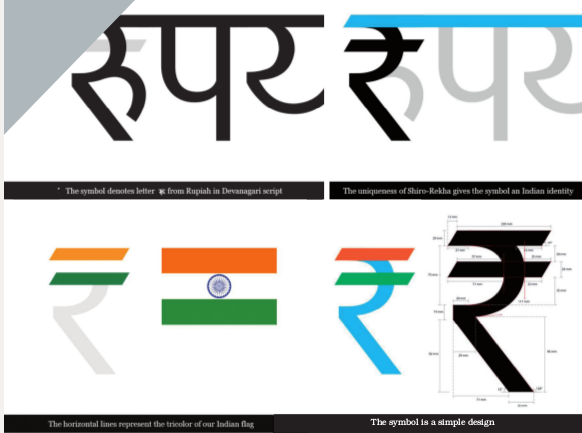
The word ‘design’ is used in two senses: design as a noun means an artifact, entity or an image that has significance in terms of beauty (aesthetics), function or purpose (teleology) or meaning (semiotics) while design as a verb denotes activity of making such artifacts or bringing such entities or images into existence. In this chapter we are going to discuss various stages of the activity of creating or making design i.e. significant artifact and in the context of graphic design, making of significant visual image. Design process involves creative thinking, imagination and visualisation. However, the way design process is practiced in the industry, it also involves not-so-creative activities.
In this chapter, an attempt has been made to out-line a design process for the graphic designer that is useful for traditional media as well as for new media.
Design process is a multi-stage process. It involves creative phase as well as non-creative phases. Therefore, apart from creative capabilities, a designer needs to develop other capabilities such as observation, research, coordination and management, technical knowledge, and persuasive capabilities. Broadly, the design process as it is practiced can be split into following phases. Although these phases are mentioned here in a particular sequence, some of the phases can happen simultaneously or recursively depending on the situation. For example, in a large studio two phases can go simultaneously, since many people will be working on the design project. Similarly, if an idea is rejected at testing or approval level by the designer himself or by the client then the whole process of idea generation is repeated.
Did you know?
The Government of India had conducted a nation-wide competition for designing a symbol of Rupee on the lines $ £ € ¥ which are widely used international currency symbols.
About 2500 entries were received from citizens of India. Five were shortlisted and from those this one ` was the most suitable.
Some day, you as a graphic designers could, also contribute to society in a significant way.
Design Processes
The design process as outlined above is very difficult to follow in its true spirit in the actual professional work conditions. The designer in general and a graphic designer in particular are engaged in design process in four different situations.
A designer can have an idea in his or her mind and then wants to pursue it to its fulfillment. In this situation a designer can enjoy full freedom to practice the design process truthfully. Secondly, a designer can be a freelancer and working with an individual client or with a company. In this case there is some freedom to the designer if the client does not influence and interfere in the process. However, in most of the cases the client will try to influence in the process. Thirdly, a designer may work in a design studio or an advertisement agency where the atmosphere is more conducive to design and only the head of the studio or agency has to interact with the client Here, a designer is free from administrative and other non creative tasks. Fourthly, a designer works in a corporate set up or in a large set up where a designer has to interact with various other stakeholders at various levels. This is the most difficult situation where the designer has to struggle at various levels for the approval of the design. There are marketing personnel who will bring in the user feedback and the designer has to take it into account. Then there will be a hierarchical process of approvals in the management that a designer has to go through. A designer has to make multiple presentations for senior managers to the top management. There will be strict constraints of time, human and financial resources.
Broad outline of the design process is as follows:
The designer is burdened with administrative responsibilities, financial constraints and design advocacy. In all these four situations design process is practiced in different ways. In the first situation designer has the most freedom. In the second and third situation designer has a reasonable freedom while in the fourth situation, the designer has more struggle and less freedom.
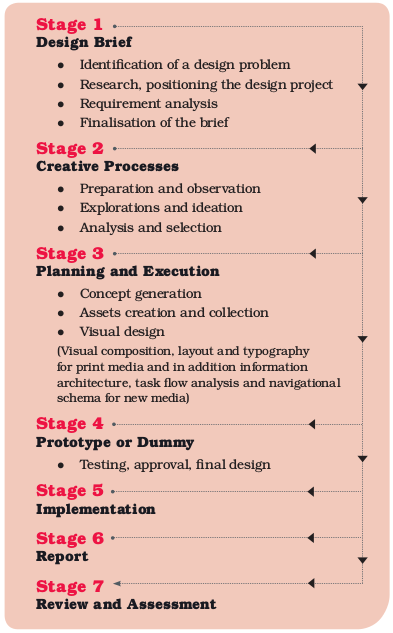
Design Brief
Normally the client gives the design project description to a designer or in some cases asks a designer to jointly prepare the brief. The brief includes detailed description about the theme of the project, target audience or the target user group, resources available, duration of the project, and finally budget of the project.

Activity 1
Based on the given sample of design brief, prepare a design brief for yourself and design the cover page of the school magazine.
Identification of Design Problem
A design problem or an issue is normally given by the client; however, a designer can come up with his or her own design problem. Typical design problems are about designing a campaign, a poster, a book, a calendar, a website, multimedia CD ROM etc. In some cases it could be about redesigning of the existing design.
Research Positioning the Design Project
Once the initial design problem is formulated, a designer conducts a thorough research about similar projects, in libraries or on the Internet and gets more information about similar existing design project and all existing solutions to the design problem and analyse them. An analysis of existing similar design projects helps in identifying the strengths and weaknesses of those existing designs. This helps a designer in properly positioning the project and develops design strategy to solve the design problem as well as planning and execution of the project.
Requirement Analysis
Based on the above research and information, the designer is supposed to conduct initial survey of the target audience or the user group and find out what are the requirements of the users. This gives a realistic understanding of the project to the designer.
Finalisation of the Brief
After gaining insights from the above mentioned stages, a designer now reflects upon the initial brief and if necessary makes the required changes. To substantiate such changes a designer can conduct a small feasibility study of the project. Normally these changes are in terms of reorientation of the theme and defining the scope of the project, more realistic estimation of time duration, resources, cost estimation and budget. Along with it in some cases the client provides certain branding and identity standards for a particular corporate. Such standards need to be adhered to for maintaining the consistency in the design for a particular organisation. Apart from such standards, a designer should also mention particular relevant international standards, if any, as a part of the brief. The final brief should clearly articulate the above as well as the user needs and business goals.
Did you know?
In design language the word ‘problem’ does not really mean something problematic. It is the design task or requirement of a client —which needs to be addressed or solved.
For example:
Pictures of food should make it good enough to be eaten on a poster of a restaurant is a problem that has to be solved.
Creative Processes
There has been always a curiosity about understanding the nature of creative process. Graphic design is no exception to it. It is believed that creative people are ‘gifted’ and bestowed with special power or gift of generating beautiful ideas. Although, there is some bit of truth in this belief, since some people are naturally fluent in generating interesting ideas and articulating them, it is also true that if a person makes efforts and understands various procedures and subtle dynamics of creative thinking and then follows it in a step-by-step manner then it can yield creative results. Creativity is a natural gift as well as it can be nurtured. Intuition and inspiration certainly aid and enhance the final results of any creative activity but in general if a designer follows a process in a certain way then that can also lead to creative output. Each graphic designer develops one’s own method for solving design problems, then evolves that method over a period of time which culminates into a special ‘style’ of that designer. No designer will view a problem from the same perspective; on the other hand, uniqueness of creative solutions lies in this specific aspect of problem perception. However, it is possible to capture major commonalities across various styles and develop a broad outline of the design process.
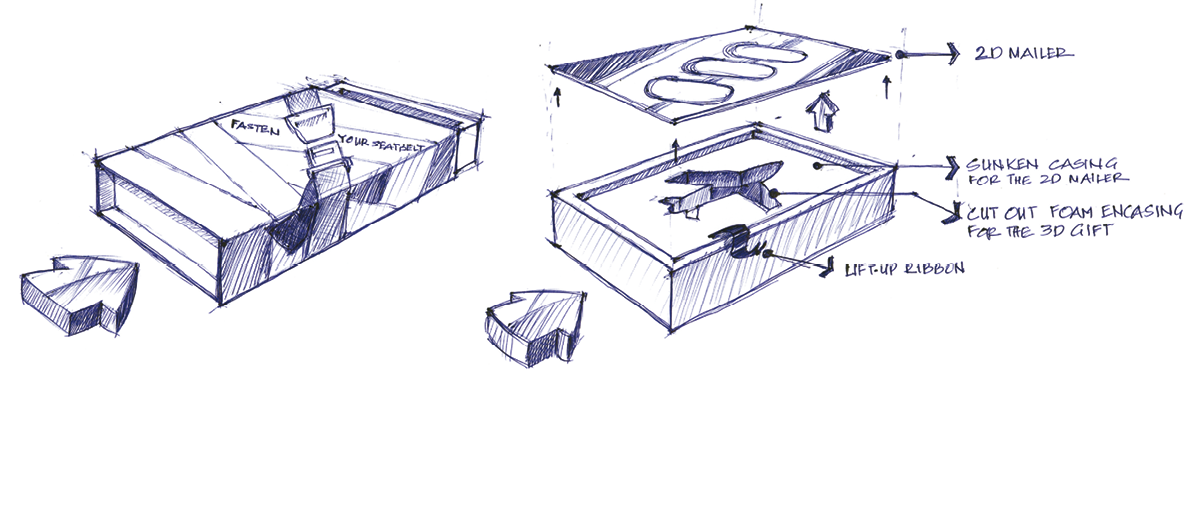

Out Sleeve - 3D Box
Open from two sides, the inside box can be pushed out from two sides. The outer of the box would be a wrap around visual of a plane seat belt. The main focus of this visual would be united part with the copy - Fasten your seat belt.
Illustrated here is a presentation style used by a designer to explain the functioning of a three-dimensional direct mailer. Such techniques help in saving time and cost of the client by presenting the concept
Inside Tray
The inside tray will have a place holder for the 2D mailer, letter and other feedback forms, which will be housed in a sunken casing. Just below this case the receiver will find encased the 3D Gift. A stain ribbon to enable the access to the 2D mailer can be also attached for easy lift-up access.
2D Mailer
The cover of this mailer will have Airplane Window Shaped Cutouts, which will show Business Executives inside – talking and discussing. When in open position the entire solution visual will appear with a copy explantation. Just above this visual there’ll be place for a pull-outcard for key benefits.
Another interesting fact about the design process is that in a professional set up, because of the work pressures and many other business compulsions, ideal design process is never followed or practiced. Always there will be compromises. Now in such a situation a graphic designer has to make a decision that to what extent one can compromise or what aspects of the process can be compromised. In spite of the harsh realities of the work environment, most of the designers try to remain as truthful as possible to the design process.
Preparation and Observation
It is said that great ideas come to the prepared minds. As a designer works on particular project ideas which right come from previous knowledge, he/she should make it a habit to be always observant about everything that is happening in surrounding. It might be something about environmental pollution, social issue, cultural event, man-made environment, seasonal changes in the nature, political developments, scientific inventions or anything that one confronts in day to-day-life. What is so special about designer’s observation is that the designer is always in search of novelty and uniqueness. She/he always tries to look around, reflects upon it and asks question to one self whether it is meaningful or not. A designer is curious about something special in the surrounding and then critically reflects upon it. If a designer finds something that is novel, unique, meaningful and special in the surrounding then he or she makes a special note of it. Some designers therefore make it a habit of documenting such ideas through sketching, photography, and recording or just keep them in the memory.
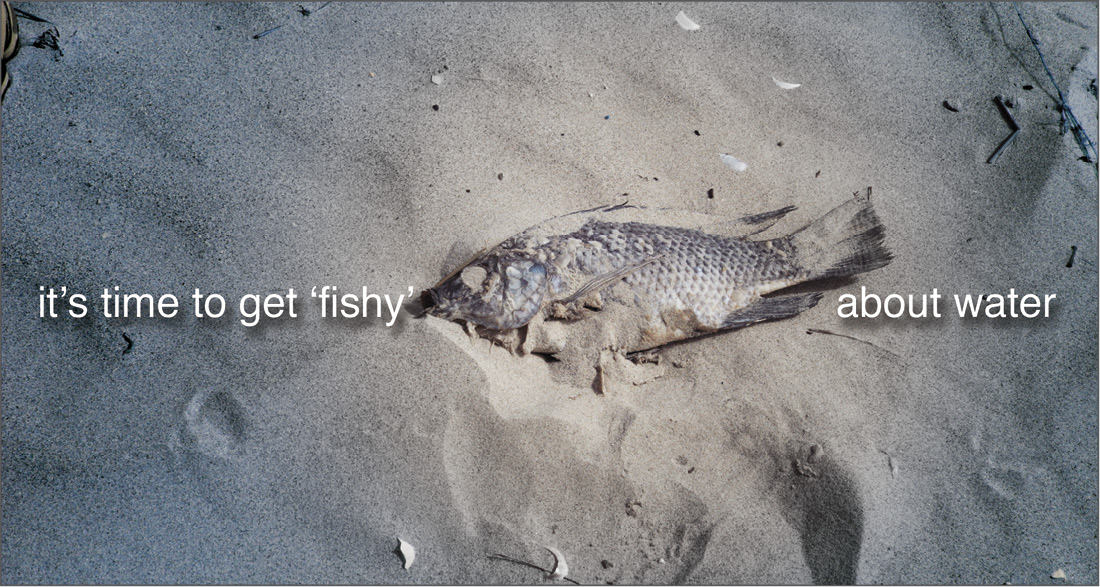
Here is a unique way in which a designer has communicated the message ‘Save Water’
Explorations and Ideation
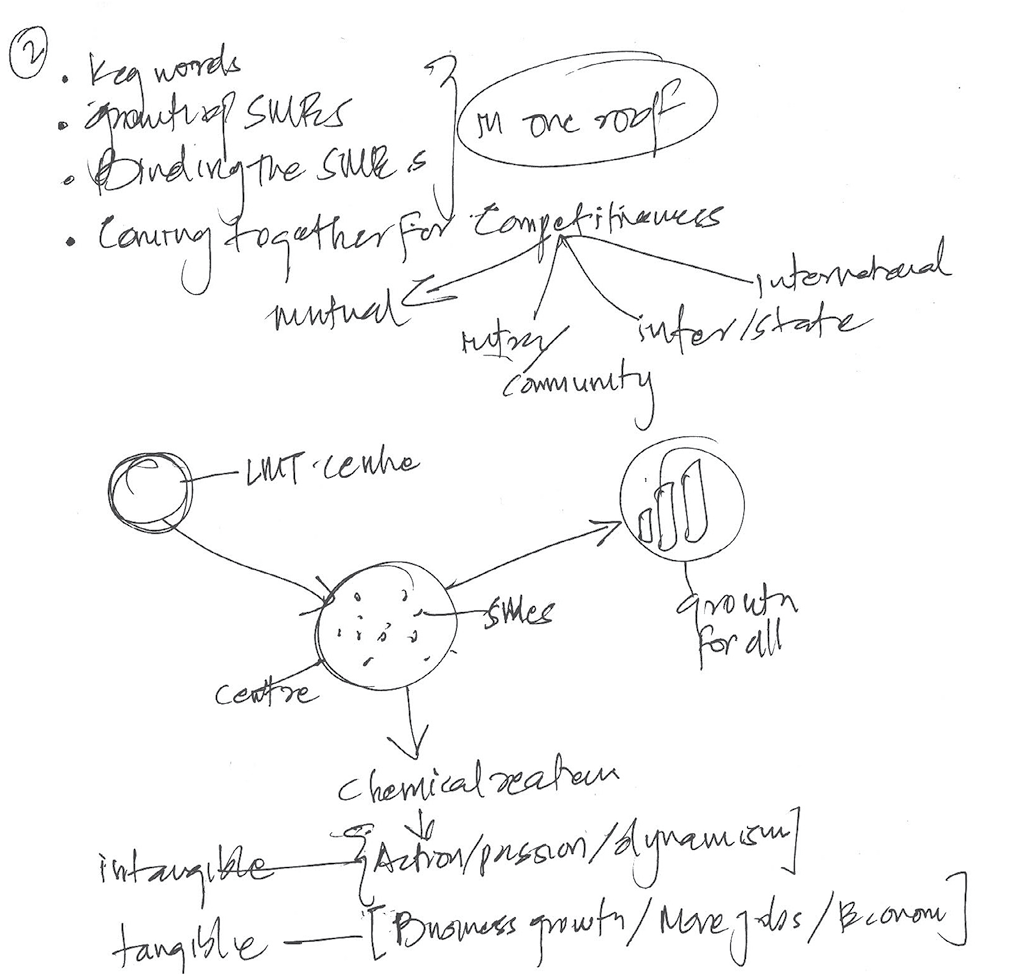
Free-form brainstorming around the central objective to be achieved
In any design project with limitless creative boundaries, it is always good to begin with creating lists of relevant words, topics, and phrases. Sort of a free-form self-brainstorming of thoughts related to the project at hand. Some are abstract and loose, some are concrete and some tightly related. By creating these lists, by doing so get a broader perspective of the problem. This helps to solve, and often uncover additional ideas and concepts which aren’t so obvious at the outset. If you are working in a group environment then always involve a diverse group of people for such an exercise. You can also conduct a brain-storming session. While generating ideas, one should not critically evaluate them. Since analysis and criticism are the main enemies of the process of ideation.
In very broad terms any creative process follows a path of
- generating lots of ideas,
- testing or evaluating ideas on the basis of some criteria, and
- selection of final idea/s.
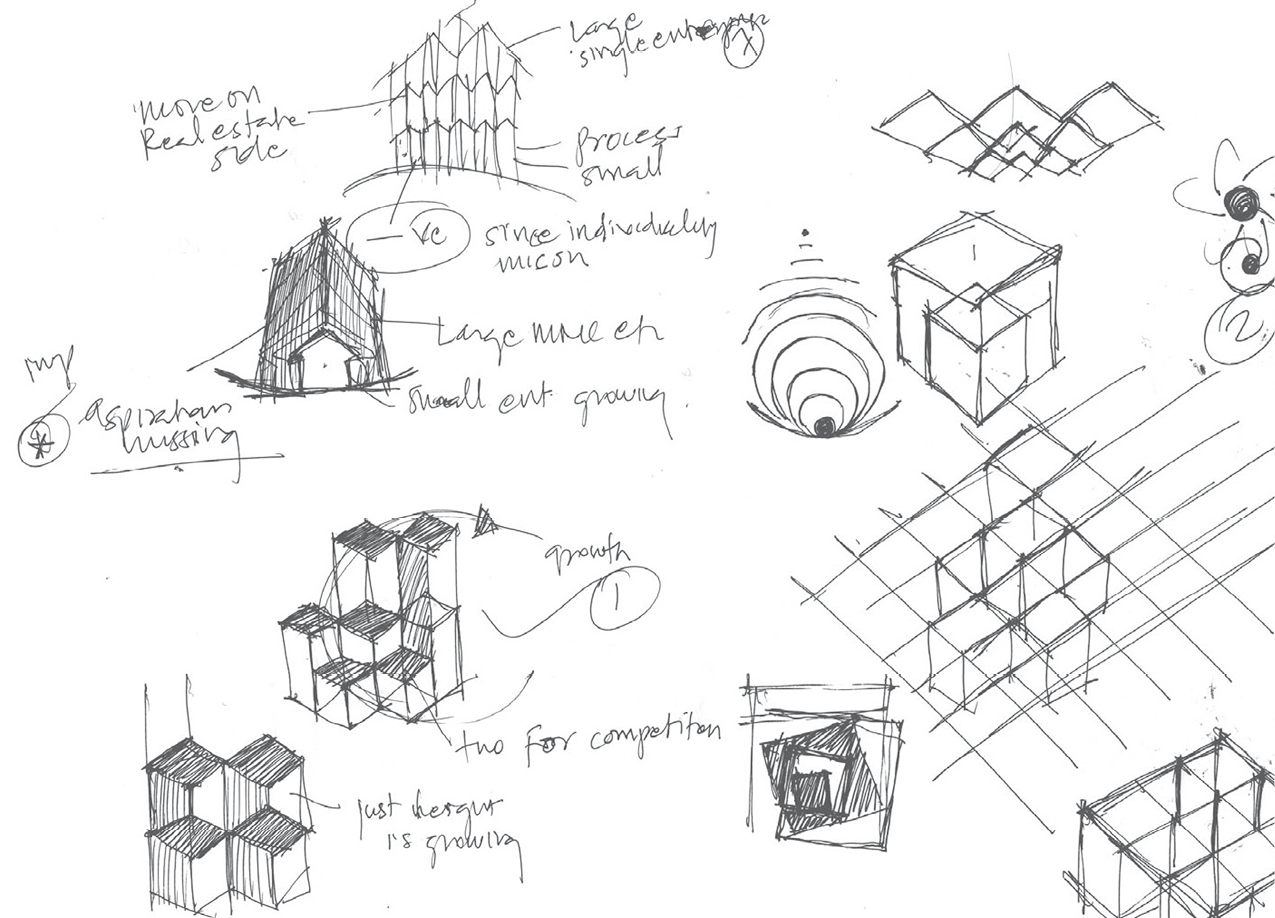
Converting written ideas to visual form through multiple sketches
This path of generate-test-select mechanism can take place iteratively i.e., again and again for solving a particular problem. The design process is iterative in nature. Typically in a recursive process a designer generates number of ideas and then applies various criteria to evaluate and eliminate many ideas and then selects final solution based on certain [other] criteria. However, if the solution is not up to the full satisfaction then again number of ideas are generated based on the previous ideas or completely from the scratch. The process goes on till the satisfactory solution is reached. Therefore, a graphic designer should make it a habit to generate lots of ideas with fluency so that one can follow the iterative process.
In principle there are no fixed procedures for explorations. Explorations should be as free and as diverse as possible. However, after years of practice designers have realised that there are certain patterns of explorations that are closely associated with thinking styles of individuals. Following such patterns might help in generating new ideas. These are not prescriptive patterns and therefore should not be considered as a recipe of creative process.
Most important phase of design process is the ideation phase i.e., the phase of creative idea generation. However, for generating novel, original and unique ideas a designer needs a certain kind of mental preparation. Creative ideas are generated through various subtle mental processes that can be broadly termed as associative thinking. During the process of associative thinking a designer tries to connect ideas and concepts freely and spontaneously or with a specific objective in mind. While doing so he follows few well defined patterns of thinking. New ideas can be generated by extending the existing ideas for example the concept of a cell phone is an extension of the concept of a telephone. Similarly, creative ideas can be generated by finding contradictions, oppositions, and contrast in the given concept or a situation. Many of the caricatures and cartoons will exhibit such qualities. There are few other non-conventional ways to generate creative idea by random association or forced association of two otherwise un-connected concepts, for instance, by connecting the concept of ‘fire’ with ‘bird’ you can generate a new concept called ‘fire-bird’ and then visualise and draw it. Similarly, one can forcefully connect two different concepts such as a chair and a Kangaroo and then start associating various features of both the concepts and ultimately come with novel ideas.
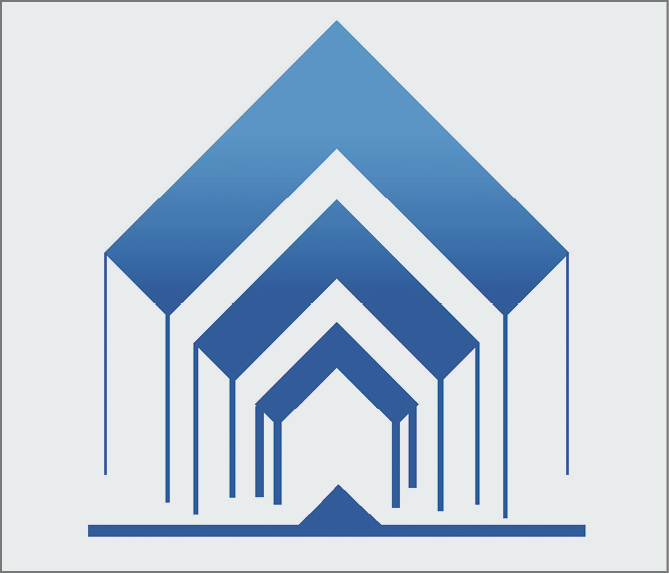
Symbol design for a training institute. This combines the concept of the ‘banyan tree’ and ‘growth’
Preparing thumbnails or documenting ideas
As the process of exploration and ideation is going on, one should always keep track of it with the help of documenting the process by various ways. The most popular method is to prepare small thumbnails.
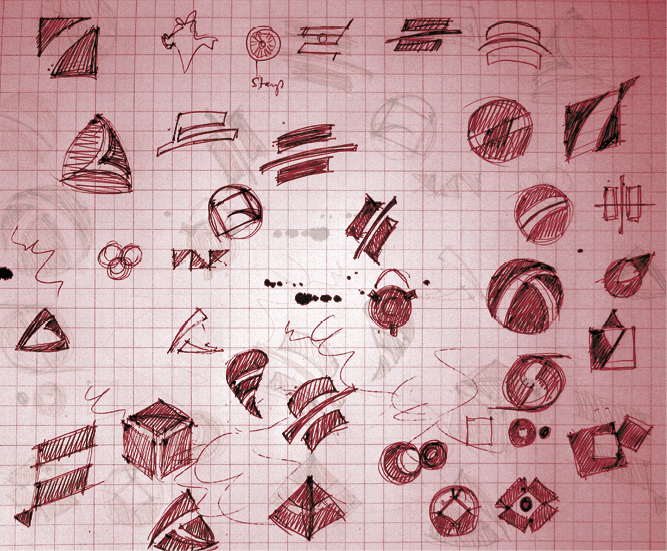
Thumbnails are small sketches which can literally be as small as your thumbnail, or as big as a couple of inches in width and height. Thumbnails are about basic ideas and core concepts. They also are intended to capture the basic ideas for page composition, like header placement, column structure, and text alignment without allowing the temptation to focus on small details too early in the process. If you are designing a website then these thumbnails are about overall lay out of a website, navigational structure, rough ideas about colour schemes, placements of various components like, animation, video clip, graphics, illustrations, photographs, all types of images and so and so forth. They can include small texts also. Thumbnails help in planning an overall layout or composition. They can be quick sketches allowing rapid idea iteration.
Activity 2
In this activity students will be introduced to the process of working with a client through a design project. They will work with a client to identify goals, target audience, and purpose of the design.
In a small group, students will go to the principal or any other person of school who will be their client and identify design problems. Children will then step by step follow the different stages of the design process such as preparation of the design brief, creative process, planning and execution of design and presenting a prototype/dummy for approval, take a feedback and make required changes in their designs.
Analysis and Selection
Once lots of ideas are generated, then is the right time to critically analyse and evaluate these ideas. For this purpose, one classifies all the generated ideas in various ways. This helps in grouping similar ideas and finding consistency among them. Also it helps in eliminating unnecessary and unrelated ideas. Classification helps in generating overall themes as well as micro details. It also helps finding gaps and scope for generating more ideas.
Once a designers reaches this stage, she/he is ready to apply various criteria for elimination, rejection or selection of ideas. The criteria could be of form and beauty, functional requirements, usability, communicability of message, technological requirements, printing issues, materials and their availability, ethical and moral issues, and many others specific to the design project.
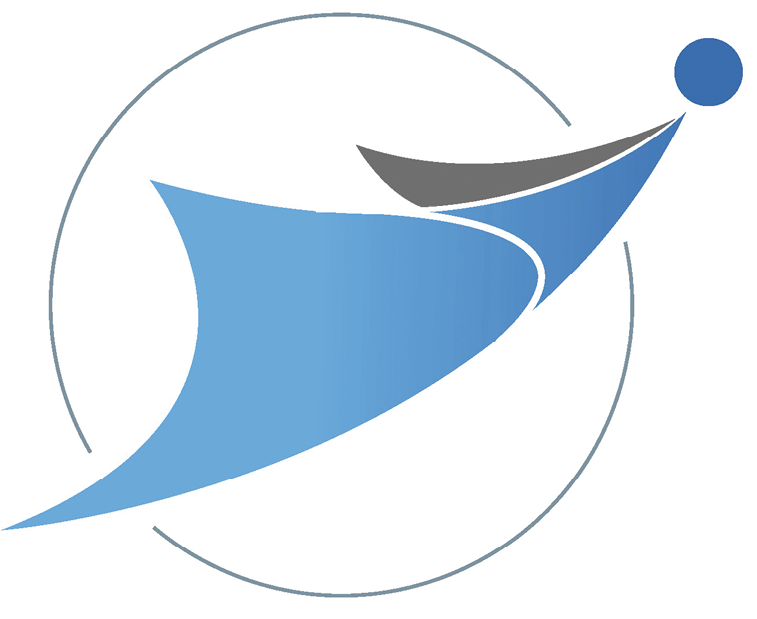
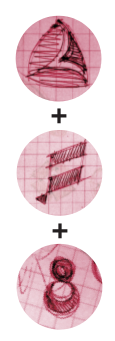
Symbol design for an institute. This combines the symbolic forms of bird, kite and human
At the end of the analysis few ideas are selected. Then if it is necessary next round of ideation can be conducted if one wants to modify these selected ideas or want to generate even better ideas. The process goes on till one is satisfied about the overall idea as well as micro level ideas.
Planning and Execution
Concept Generation
This is the stage when the overall visual theme, treatment and visual language for the design are decided. In practice at least three to five such concepts/themes are developed out of which client selects the final one. In some cases the client rejects all the concepts. In some cases client may ask the designer to merge some of the concepts or make some minor or major modifications in the generated concepts.
Assets Creation and Collection
Since the final idea or set of few final concepts are in place, now a designer needs to create all the required materials necessary to execute the design. This may include high quality illustrations, images, sketches, photographs, animations, video clips, and all types of texts—slogans, captions, and textual contents and so on.
Visual Design
The most important fact about design is its visual composition, whether it’s a print media or the new media. Visual look and feel is very critical for the success of the design. To achieve that a designer has to plan and execute well balanced visual composition for the design. All the visual and textual assets have to be organised properly and arranged in such a way that the overall design should make an impact. Selectively chosen photographs or illustrations can create enormous visual impact for a design, adding dimension, meaning, and a deeper level of understanding far beyond a well-written headline or paragraph of text. Designer should adhere to the principles of design as discussed elsewhere in this book to achieve this. A designer must make it a habit to prepare thumbnails or rough key sketches for visual design as discussed earlier.
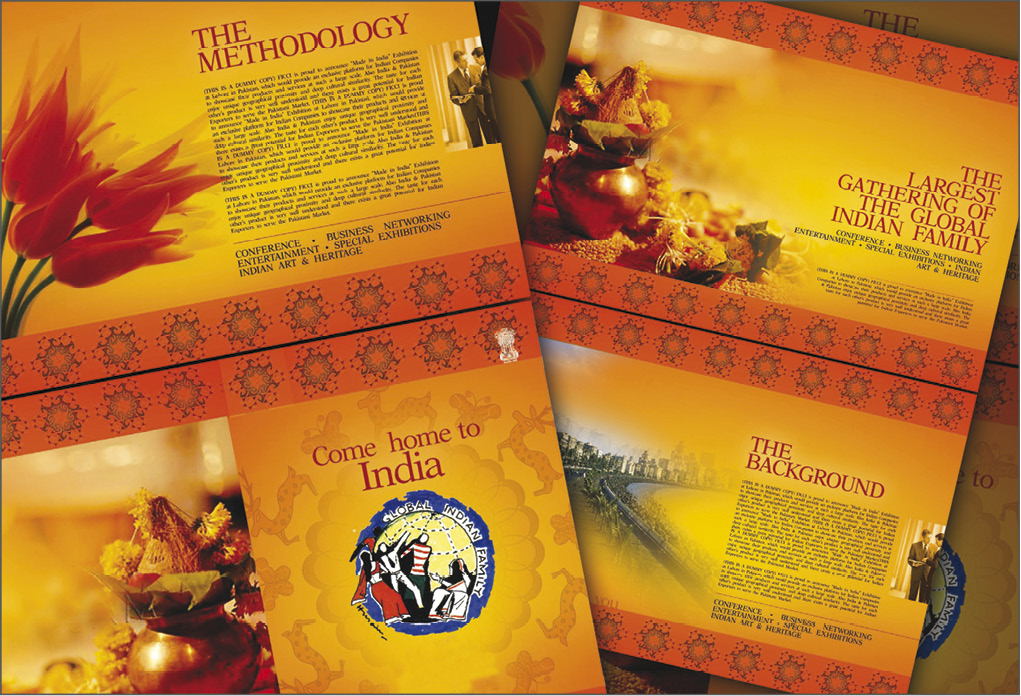
Visual metaphors of colours and symbolic forms
Layout, grid and typography are the crucial elements in setting the visual theme and mood of a design whether it is for print media or the new media. Evocations of different typefaces are subliminal to most people, but a designer will go to great lengths to ensure the selection and construction of type complements the mood of the piece. Variety of type faces and their qualities as discussed in this book elsewhere are very important for making a design effective, verbally as well as visually. Overall layout and grid provides broader structure to the design bringing in a kind of visual stability to the design.
Conceived design just obscures the intention or message of the design. Principles of design such as contrast, balance, rhythm, and proportion are very useful in achieving the desired effect. This comes just as much into play with use of imagery, illustration, text as visual elements, photograph and even animation in the case of a website, in a composition as it does within the image itself. Effectively integrating all these assets into a design requires an awareness of principles of design. Compact areas of motion and activity, countered with spaces for the eye to rest and relax generate a visual rhythm.
In a new media design project one has to also take care of information architecture i.e. all the textual content and information is organised. One has to understand patterns of interaction of the user with the website or the multimedia CD ROM and prepare the task flow diagrams. Similarly, a navigational schema needs to be developed. All these are highly specialised areas of new media design.
Prototype or Dummy
Traditionally it is called preparing an ‘artwork’ for the design. However, with the advent of Information Technology final art work is done with sophisticated software tools. Normally, dummy for a print media is supposed to be of the same size i.e. of the actual size of the final design.
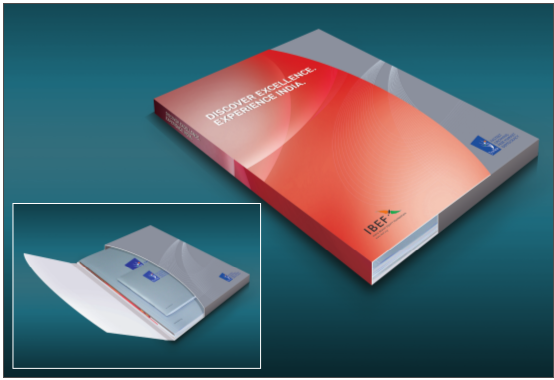
Digital prototype for a folder design explaining its functioning using digital software tools. (inset) Open position of the folder with inside jacket design.
Then dummies for at least three chosen concept is prepared which looks exactly like a final design and then presented before the client for the approval. Often the client makes few suggestions as per his/her requirements.
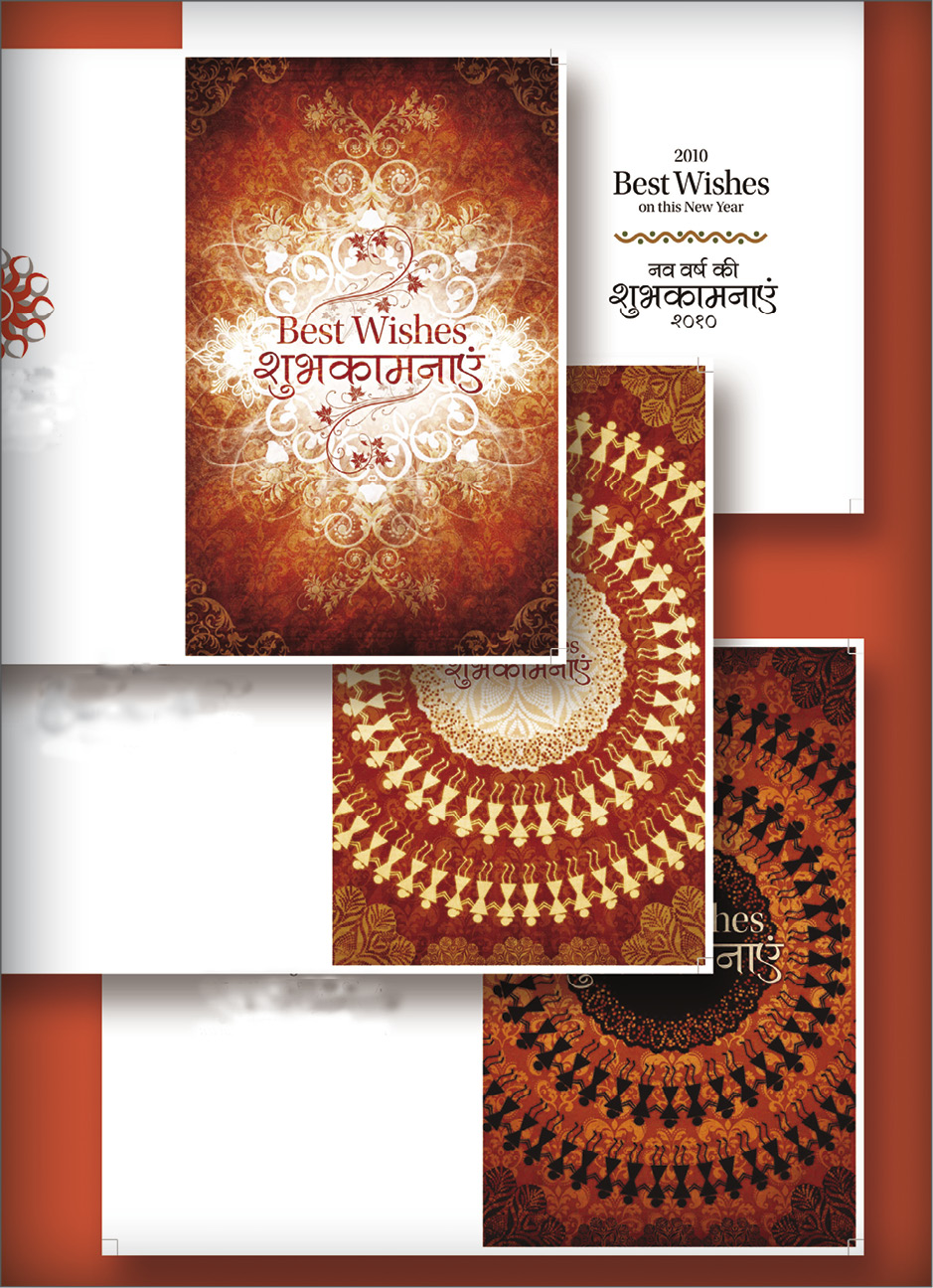
These suggestions are incorporated in the final design which is normally termed as a ‘Camera Ready Copy’ of the design. While preparing this copy one has to take into account all the issues related to printing such as the quality of paper on which it is going to be printed, quality of inks, printing technology and so on and so forth.
If it is a new media design such as a website or multimedia CD ROM or a DVD then it goes through a rigorous process of testing. While designing such a product the usability concerns as discussed later in this book should be kept in the mind. The design process does not end here. Additional reviews and approval cycles, more design iterations, and frequent user testing all may be executed anywhere into this process. It’s not always predictable, and may not always function as assumed by the designer. It has to go through the system-level testing, because a new media product should be compatible with various hardware and software on which it is supposed to work. Many a times the first in-house testing is called alpha-testing which is done within the organisation as the users of the product. The second testing is called beta-testing which is done with limited number of actual users of the product. In both the cases normally paper prototypes or wire-frame models are first prepared and then tested with the users. If there are any issues then the entire process can be repeated or parts of the process are repeated. Once the design satisfactorily, fulfils the requirements then only the product is launched.

Proofing process with separate CMYK plates
As already mentioned, the design process is not followed very strictly in the industry. What ever is discussed here is the ideal case. However, it is up to the designer to what extent one can adhere to the design process considering the work environment and professional pressures. However, there is no doubt that the most fascinating part of the design process is the creative phase of ideation or explorations on which one cannot afford to compromise.
Implementation
The designer prepares the artwork, now-a-days in a digital form or files and provides a printed copy which is termed as ‘a proof’. Then it is approved by the client by signing it or mark-up changes to it. Then a further ‘proof’ is provided if required.
Next stage is a more a technical stage where one takes the design for printing in case of traditional media and uploading incase of new media then it goes to the web developer or a multimedia developer.
The designer forwards the artwork to a commercial printer and then the printer gets a printed copy or a ‘proof’. It goes back to the designer and then also to the client for approval. In the case of new media a pilot version is launched on the web. Also a soft copy is given to the designer and the client for approval. Technical flaws or suggestions, if any, are fixed and then the work is published.
Report
In traditional media there is no such norm to prepare a report about the design however, some designers prefer to prepare a report for future use. In the case of new media in many organisations, it is mandatory to prepare a design specification document. The design specification documents which mainly consist of the whole process of design along with the technical information about the hardware, software used, critical code, description of standards followed, details of the specifications of the final output in terms of its dimensions and any other matter as per the organisational norms.
Review and Assessment
Once the design is launched, the client is curious about its impact on the users or the target audience. Therefore, a review is conducted by the designer or by a third party agency.
Exercise
1. Keeping in mind the different stages of design, explain how the design processes is a recursive process.
2. What criteria should be applied for the elimination or selection of ideas?
3. According to you, is creativity a gift or it can be nurtured?
4. How does brainstorming help in the ideation process?
5. What are the different stages a graphic designer has to go through from conceptualisation to the end product?
Unit 2
Principels and Elements of Design
Design has three core components: Form (aesthetics), function (teleology), and meaning (semiotics). This unit focuses on the first component i.e. `Form’ or `Aesthetics’. Although design has a certain purpose to fulfill, it is achieved in a style. The element of beauty distinguishes design from other mundane objects. Therefore, the formal aspects of design have special importance. This unit discusses formal aspects of design such as drawing, colour, typography, layout and composition. The chapters from three to seven deal with them.
Drawing is a representation of ideas in visual form. In design, drawing is used as a tool for ‘visualisation’. Drawing is an engaging activity where the total involvement of a designer is expected. It trains eyes to look for novelty and uniqueness in the surroundings. It also trains our concentration for achieving precision, attention to details and eye-hand coordination. More importantly, as the word `draw’ means `to pull’; drawing `from within’ i.e., expression of inner nature and drawing `from without’ i.e., representing outer nature help designer to connect one’s self with the other individuals and the society in a meaningful way.
Colour is another vital concept that designer needs to study in detail. This unit will try to provide more a comprehensive view on colour and its applications in graphic design. Specifically it deals with various theories of colour including scientific perspective, colour schemes, colour interactions and semiotics of colours i.e. colour symbolism.
Another important component of design is composition. Layout design is a more specialised aspect of composition. A `good design’ is a good composition and layout. The desired impact of a design depends on the appropriate application of principles of composition. A good design composition, due to its organic structure, communicate and offer a unique experience of its own. It effectively communicates the message and at a subjective level aesthetically influences the viewers. Typography is also an essential part of graphic design today. A designer carefully chooses fonts after understanding the design problem, the medium, target audience, production aspects and the context and then integrates them in the composition.